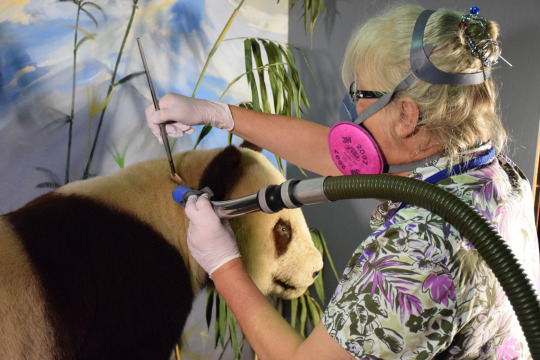
by Kathleen Bodenlos
Gretchen Anderson is a conservator at Carnegie Museum of Natural History. She is restoring a panda diorama that will be prominently placed in our newly renovated gift shop. (Stay tuned for more on the gift shop in the next few weeks).
Here are 5 surprising things about conservation of a diorama.
1. Less is more: Use as few chemicals as possible
- Soot sponges, water, and vacuums are the top
choices in lieu of harsh chemicals. Water is one of the most powerful solvents! - Gretchen begins with a fan brush and a HEPA (high-efficiency particulate air filter) vacuum to remove as much dust and arsenic traces as possible.
- She is wearing a protective face mask and gloves to protect herself from any arsenic that might be stirred up.
- Soot sponges are a rubber sponge designed to absorb soot and are used dry. Another handy tool is a makeup sponge. A make-up sponge is used when just a little tiny bit of water is needed to move the dirt.
- Particulate dust (dust, dirt and soot) is extremely damaging to museum collections. It is best to remove it.

2. Some conservationists also do a little restoration on paint
- When in doubt go lighter to match a color
- Think impressionism and mottle with several colors if possible. A good example is the natural colors on a rock.

3. Move ‘em up and head ’em out—RAWHIDE!
- For many older dioramas, the skin of the animal is literally a raw hide. They are often treated with arsenic to keep the hide from becoming infested with insects and being eaten/damaged
- Mercury, and other pesticides were also used to prevent insect attack on some museum collections.
- A sealed exhibit case helps to keep the diorama safe from damage. Dust and insects are kept out. If there are any pesticides inside the case these are kept in – protecting the public.
- Plant material
· Not all of it is fake. Some of the actual plant materials are painted to make them look alive
· Even a non-expert can discern what is fake and what is real upon close examination - Save money—use less
· When washing clothes the soap is to keep dirt from settling back on clothes
· Agitation and water are the real cleaner
· Use 1/3 less soap and your clothes will be clean
and you will ensure that all the soap is removed which will help protect your
skin
Kathleen Bodenlos is the Director of Marketing at Carnegie Museum of Natural History. Museum employees are encouraged to write about their unique experiences.
